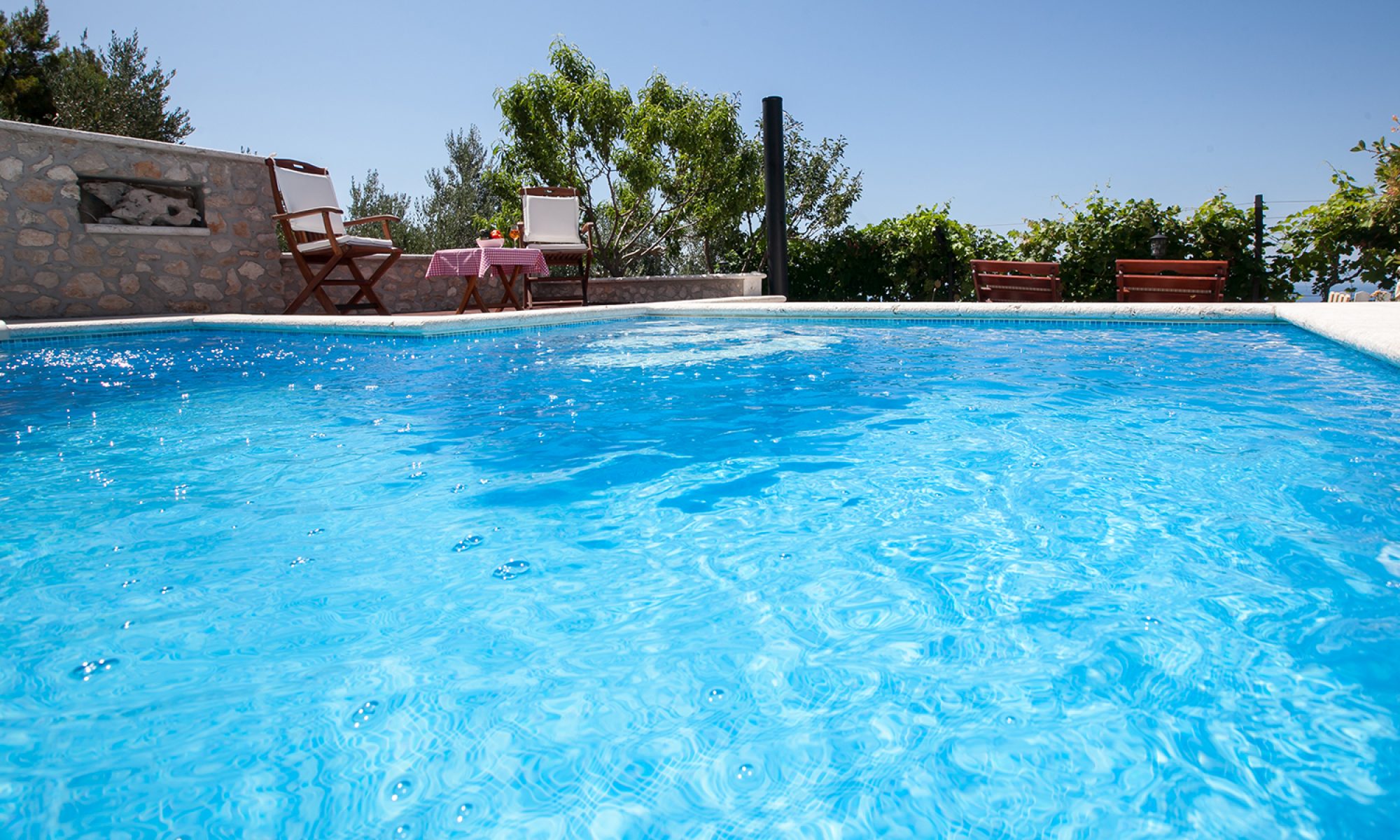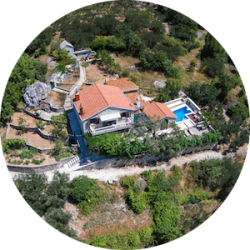Makarska
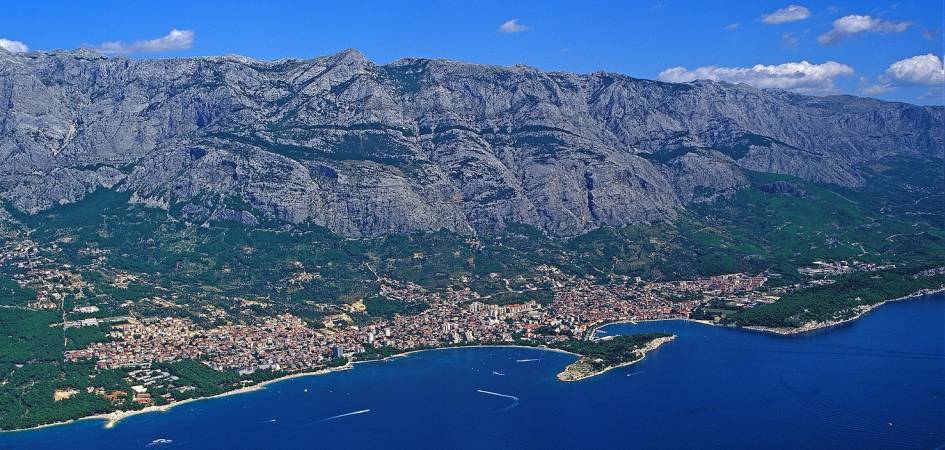
Makarska has always been the center of the surrounding region known as Makarska Riviera, both in an administrative, political and economic sense, as well as a center of culture, education, and since the mid twentieth century, tourism. Today, it is a city of more than 15 thousand inhabitants that encompasses picturesque villages at the foot of the Biokovo Mountain, including Veliko Brdo, Puharići, Kotišina and Makar (which is where the name of Makarska comes from).
Makarska is one of the most famous tourist destinations on the Croatian coast, attractive for its nature and good climate, rich in tourist attractions and full of hospitable hosts.

To this day, Makarska is known for its sandy beach, which is almost 2 kilometers long. The walkways are lined with pine trees and surrounded by luxury hotels, tourist facilities, and gastronomical havens, and there is plenty of fun for both adults and children.
Makarska is located below the mountain of Biokovo (1762 m), which protects it from the harsh continental climate and is responsible for its rich Mediterranean vegetation, mild winters, long, warm summers cooled by a refreshing breeze called maestral.
Makarska has more than 2750 hours of sun each year and the air temperature above 20°C from July to September. During these same months, the
crystal-clear sea also averages a temperature of above 20°C.
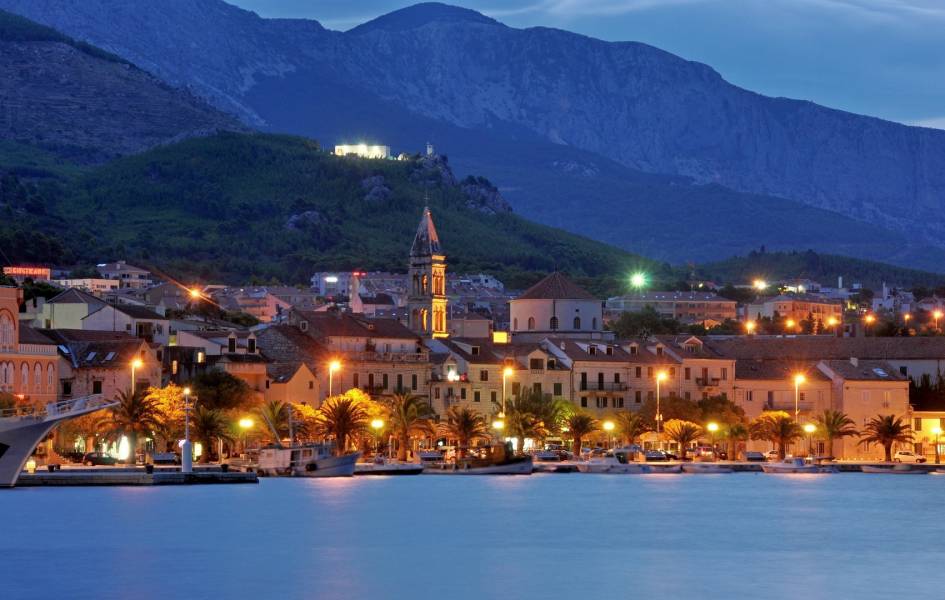
The city of Makarska grew around a natural harbor protected by a picturesque peninsula of Sveti Petar (St. Peter) and the cape Osejava. It is the only harbor of this kind between the mouth of the Cetina and Neretva rivers. In the past it provided protection and safe harbor during stormy weather to sailors, pirates and merchants, and nowadays it does the same for yachts, sailing boats and tourist ships. This contributed to its development into a trading port, especially during the Ottoman and Venetian occupation. Today, there is a ferry line which runs a few times a day from Makarska to Sumartin on the island Brač.
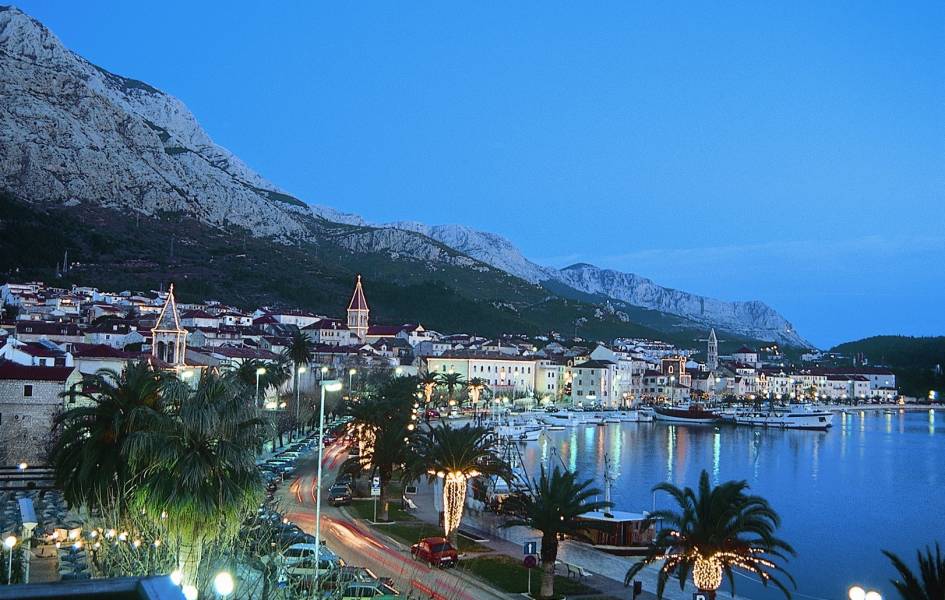
During the summer months the harbor fills up with yachts and tourist ships, while young people crowd the main Kačić square enjoying entertain¬ment and cultural performances.
As the night goes on, Makarska be¬comes livelier and livelier, and its ca¬fes, restaurants and discotheques fill up.
The best way to become familiar with the history of this city is by visit¬ing the Franciscan monastery which recently celebrated its 500th anniversary.
The monastery boasts a picture gallery, library, one-of-a-kind Malaco-logical museum (dedicated to the study and preservation of mollusks) and the Institute of Mountains and Sea. The church of St. Marko is located on the Kacic square. On its north side are: the Gojak gallery, located in the old school building, public library, the school of music, and the headquarters of the Makarska Riviera radio.
The city museum can be found on the waterfront, as well as the church of St. Filip. The renovated church of St. Petar is located in the St. Petar park, a spot with a beautiful view of the city, magnificent Mount Biokovo and the open sea.
Makarska's geographical position is 44° 17' 38" latitude and 17° 1' 20" longitude, which places it approxi¬mately in the center of north-western half of the Makarska coast.
History
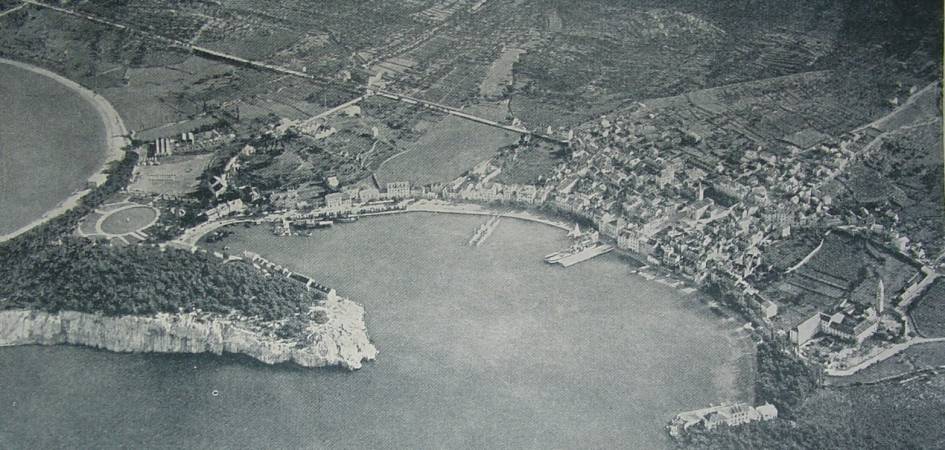
The first recorded settlement in these parts as a waypoint on the Salona-Narona road, which was mentioned in the tablet of Peutigeriana in the first half of the 4th century.
In the documents of the Salona Council dated from May 4th, 533 AD, Mucurum is mentioned as the town where a bishopric was established. In the Ravenat itinerary from the 7th century, the town is mentioned as Aronia id est Mucru. During the middle ages, the county Mokro was part of the Neretva dukedom and was renowned for its naval might. Venetian doge Petar Kandijan suffered a significant defeat in the large naval battle in front of Mokro on September 18th, 887 AD. In the centuries that followed, the rule over these parts was exchanged between the various Bribir dukes, Bosnian rulers, Croatian kings and Venice. Under its present name Makarska is mentioned for the first time in 1502. During the Turkish occupation, Makarska became part of their province Primorje and was fortified with three keeps. Makarska became a part of Venetian republic in 1684. Under the hundred-year rule of the Venetian lion, the foundations of the future city were built. In the following hundred or so years, during the French and Austrian rule, the city experiences increased cultural and economic development.
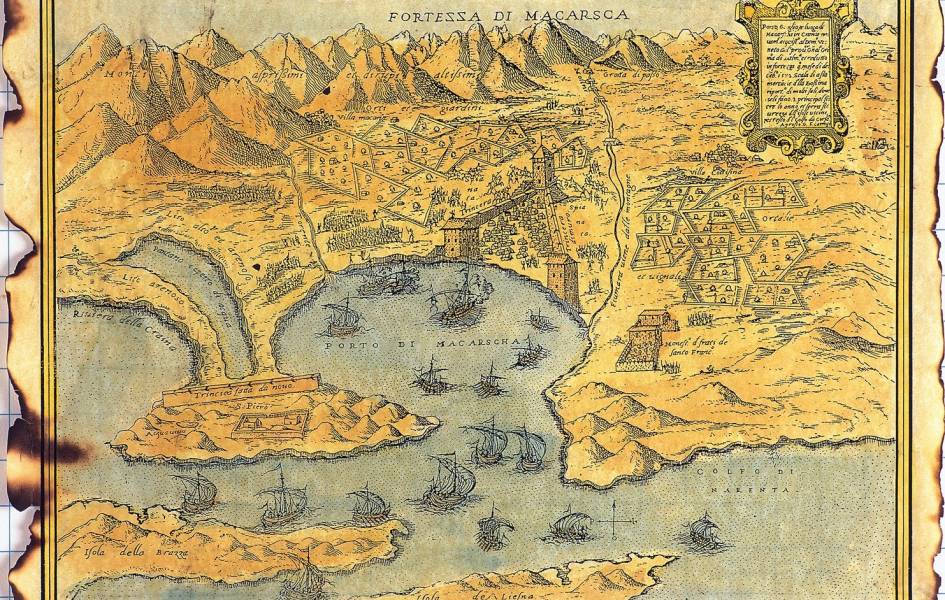
From the prehistoric Illyrian artifacts, Roman villas, medieval naval might of Mokro in the Neretva Dukedom, to the Turkish walls and the Venetian Baroque town; through popular Austrian resort town to the present day, Makarska and its story are an integral part of it natural environment. The historical story of the city can be experienced through the famous Franciscan monastery, the cathedral church of St. Marko, the churches of St. Filip and Jakov, the shrine of Vepric, Kačić square, various museums and galleries, stone paved streets, squares, beaches, groves and mountain peaks.
 Makarska has always been the center of the surrounding region known as Makarska Riviera, both in an administrative, political and economic sense, as well as a center of culture, education, and since the mid twentieth century, tourism. Today, it is a city of more than 15 thousand inhabitants that encompasses picturesque villages at the foot of the Biokovo Mountain, including Veliko Brdo, Puharići, Kotišina and Makar (which is where the name of Makarska comes from).
Makarska is one of the most famous tourist destinations on the Croatian coast, attractive for its nature and good climate, rich in tourist attractions and full of hospitable hosts.
Makarska has always been the center of the surrounding region known as Makarska Riviera, both in an administrative, political and economic sense, as well as a center of culture, education, and since the mid twentieth century, tourism. Today, it is a city of more than 15 thousand inhabitants that encompasses picturesque villages at the foot of the Biokovo Mountain, including Veliko Brdo, Puharići, Kotišina and Makar (which is where the name of Makarska comes from).
Makarska is one of the most famous tourist destinations on the Croatian coast, attractive for its nature and good climate, rich in tourist attractions and full of hospitable hosts.
 To this day, Makarska is known for its sandy beach, which is almost 2 kilometers long. The walkways are lined with pine trees and surrounded by luxury hotels, tourist facilities, and gastronomical havens, and there is plenty of fun for both adults and children.
Makarska is located below the mountain of Biokovo (1762 m), which protects it from the harsh continental climate and is responsible for its rich Mediterranean vegetation, mild winters, long, warm summers cooled by a refreshing breeze called maestral.
Makarska has more than 2750 hours of sun each year and the air temperature above 20°C from July to September. During these same months, the
crystal-clear sea also averages a temperature of above 20°C.
To this day, Makarska is known for its sandy beach, which is almost 2 kilometers long. The walkways are lined with pine trees and surrounded by luxury hotels, tourist facilities, and gastronomical havens, and there is plenty of fun for both adults and children.
Makarska is located below the mountain of Biokovo (1762 m), which protects it from the harsh continental climate and is responsible for its rich Mediterranean vegetation, mild winters, long, warm summers cooled by a refreshing breeze called maestral.
Makarska has more than 2750 hours of sun each year and the air temperature above 20°C from July to September. During these same months, the
crystal-clear sea also averages a temperature of above 20°C.
 The city of Makarska grew around a natural harbor protected by a picturesque peninsula of Sveti Petar (St. Peter) and the cape Osejava. It is the only harbor of this kind between the mouth of the Cetina and Neretva rivers. In the past it provided protection and safe harbor during stormy weather to sailors, pirates and merchants, and nowadays it does the same for yachts, sailing boats and tourist ships. This contributed to its development into a trading port, especially during the Ottoman and Venetian occupation. Today, there is a ferry line which runs a few times a day from Makarska to Sumartin on the island Brač.
The city of Makarska grew around a natural harbor protected by a picturesque peninsula of Sveti Petar (St. Peter) and the cape Osejava. It is the only harbor of this kind between the mouth of the Cetina and Neretva rivers. In the past it provided protection and safe harbor during stormy weather to sailors, pirates and merchants, and nowadays it does the same for yachts, sailing boats and tourist ships. This contributed to its development into a trading port, especially during the Ottoman and Venetian occupation. Today, there is a ferry line which runs a few times a day from Makarska to Sumartin on the island Brač. During the summer months the harbor fills up with yachts and tourist ships, while young people crowd the main Kačić square enjoying entertain¬ment and cultural performances.
As the night goes on, Makarska be¬comes livelier and livelier, and its ca¬fes, restaurants and discotheques fill up.
The best way to become familiar with the history of this city is by visit¬ing the Franciscan monastery which recently celebrated its 500th anniversary.
The monastery boasts a picture gallery, library, one-of-a-kind Malaco-logical museum (dedicated to the study and preservation of mollusks) and the Institute of Mountains and Sea. The church of St. Marko is located on the Kacic square. On its north side are: the Gojak gallery, located in the old school building, public library, the school of music, and the headquarters of the Makarska Riviera radio.
The city museum can be found on the waterfront, as well as the church of St. Filip. The renovated church of St. Petar is located in the St. Petar park, a spot with a beautiful view of the city, magnificent Mount Biokovo and the open sea.
Makarska's geographical position is 44° 17' 38" latitude and 17° 1' 20" longitude, which places it approxi¬mately in the center of north-western half of the Makarska coast.
During the summer months the harbor fills up with yachts and tourist ships, while young people crowd the main Kačić square enjoying entertain¬ment and cultural performances.
As the night goes on, Makarska be¬comes livelier and livelier, and its ca¬fes, restaurants and discotheques fill up.
The best way to become familiar with the history of this city is by visit¬ing the Franciscan monastery which recently celebrated its 500th anniversary.
The monastery boasts a picture gallery, library, one-of-a-kind Malaco-logical museum (dedicated to the study and preservation of mollusks) and the Institute of Mountains and Sea. The church of St. Marko is located on the Kacic square. On its north side are: the Gojak gallery, located in the old school building, public library, the school of music, and the headquarters of the Makarska Riviera radio.
The city museum can be found on the waterfront, as well as the church of St. Filip. The renovated church of St. Petar is located in the St. Petar park, a spot with a beautiful view of the city, magnificent Mount Biokovo and the open sea.
Makarska's geographical position is 44° 17' 38" latitude and 17° 1' 20" longitude, which places it approxi¬mately in the center of north-western half of the Makarska coast.
 The first recorded settlement in these parts as a waypoint on the Salona-Narona road, which was mentioned in the tablet of Peutigeriana in the first half of the 4th century.
In the documents of the Salona Council dated from May 4th, 533 AD, Mucurum is mentioned as the town where a bishopric was established. In the Ravenat itinerary from the 7th century, the town is mentioned as Aronia id est Mucru. During the middle ages, the county Mokro was part of the Neretva dukedom and was renowned for its naval might. Venetian doge Petar Kandijan suffered a significant defeat in the large naval battle in front of Mokro on September 18th, 887 AD. In the centuries that followed, the rule over these parts was exchanged between the various Bribir dukes, Bosnian rulers, Croatian kings and Venice. Under its present name Makarska is mentioned for the first time in 1502. During the Turkish occupation, Makarska became part of their province Primorje and was fortified with three keeps. Makarska became a part of Venetian republic in 1684. Under the hundred-year rule of the Venetian lion, the foundations of the future city were built. In the following hundred or so years, during the French and Austrian rule, the city experiences increased cultural and economic development.
The first recorded settlement in these parts as a waypoint on the Salona-Narona road, which was mentioned in the tablet of Peutigeriana in the first half of the 4th century.
In the documents of the Salona Council dated from May 4th, 533 AD, Mucurum is mentioned as the town where a bishopric was established. In the Ravenat itinerary from the 7th century, the town is mentioned as Aronia id est Mucru. During the middle ages, the county Mokro was part of the Neretva dukedom and was renowned for its naval might. Venetian doge Petar Kandijan suffered a significant defeat in the large naval battle in front of Mokro on September 18th, 887 AD. In the centuries that followed, the rule over these parts was exchanged between the various Bribir dukes, Bosnian rulers, Croatian kings and Venice. Under its present name Makarska is mentioned for the first time in 1502. During the Turkish occupation, Makarska became part of their province Primorje and was fortified with three keeps. Makarska became a part of Venetian republic in 1684. Under the hundred-year rule of the Venetian lion, the foundations of the future city were built. In the following hundred or so years, during the French and Austrian rule, the city experiences increased cultural and economic development.
 From the prehistoric Illyrian artifacts, Roman villas, medieval naval might of Mokro in the Neretva Dukedom, to the Turkish walls and the Venetian Baroque town; through popular Austrian resort town to the present day, Makarska and its story are an integral part of it natural environment. The historical story of the city can be experienced through the famous Franciscan monastery, the cathedral church of St. Marko, the churches of St. Filip and Jakov, the shrine of Vepric, Kačić square, various museums and galleries, stone paved streets, squares, beaches, groves and mountain peaks.
From the prehistoric Illyrian artifacts, Roman villas, medieval naval might of Mokro in the Neretva Dukedom, to the Turkish walls and the Venetian Baroque town; through popular Austrian resort town to the present day, Makarska and its story are an integral part of it natural environment. The historical story of the city can be experienced through the famous Franciscan monastery, the cathedral church of St. Marko, the churches of St. Filip and Jakov, the shrine of Vepric, Kačić square, various museums and galleries, stone paved streets, squares, beaches, groves and mountain peaks. 